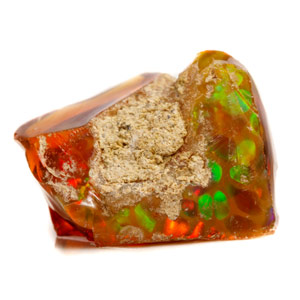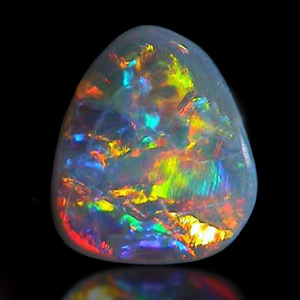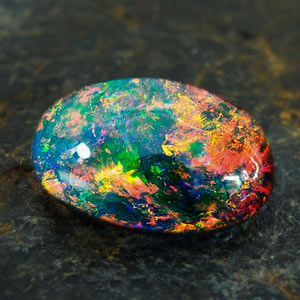opal
Opal, a gemstone celebrated for its kaleidoscope of colours, derives its name from the Latin word "opalus," meaning "precious stone." This moniker aptly captures the enchanting allure of opals, which are composed of hydrated silicon dioxide.
Opals form through a unique geological process involving the percolation of silica-rich water into cavities in sedimentary rocks. Over time, as this water evaporates, it leaves behind tiny spheres that diffract light, creating the mesmerising play of colours known as "opalescence." This optical phenomenon is what makes opals so captivating.
Notably, opals are found in various regions, with Australia being a primary source, including the famous Lightning Ridge and Coober Pedy deposits. Ethiopia and Mexico also yield opals of exceptional beauty.
One fascinating fact about opals is that they can display a stunning range of colours, from milky white and fiery red to deep blue and vibrant green. This gemstone has long been associated with magic and mystery and continues to captivate gem enthusiasts with its unique charm.
Click on the terms in the table below to discover their meaning
Click on the terms in the table below to discover their meaning
| Name | Opal |
|---|---|
| Category | Tectosilicate mineraloid |
| Chemical Formula | SiO2 · nH2O |
| IMA Symbol | Opl |
| Crystal System | Amorphous |
| Crystal Habit | Amorphous, massive, reniform |
| Twinning | Absent |
| Cleavage | None |
| Fracture | Conchoidal |
| Tenacity | Brittle |
| Hardness (Moh's Scale) |
5.5 - 6.5 |
| Specific Gravity | 1.9 - 2.3 |
| Diaphaneity | Transparent to translucent |
| Colour | Colourless, white, yellow, orange, red, blue, green, brown, black |
| Streak | White |
| Lustre | Vitreous, resinous or waxy |
| Optical Class | Isotropic |
| Refractive index | n = 1.400 - 1.460 |
| Birefringence | Absent; anomalous birefringence may be present due to stress-induced water loss |
| Dispersion | Rd = 0.009 - 0.013 |
| Pleochroism | Absent |
| Clarity | Type I |
| Notable Varieties | Precious Opal, Crystal Opal, Fire Opal, Hydrophane, Hyalite, Prase Opal |
References
Hudson Institute of Mineralogy. (2023). Opal. Retrieved from Mindat.org: https://
Mineralogy Database. (2012, September 5). Opal Mineral Data. Retrieved from Mineralogy Database: https://


